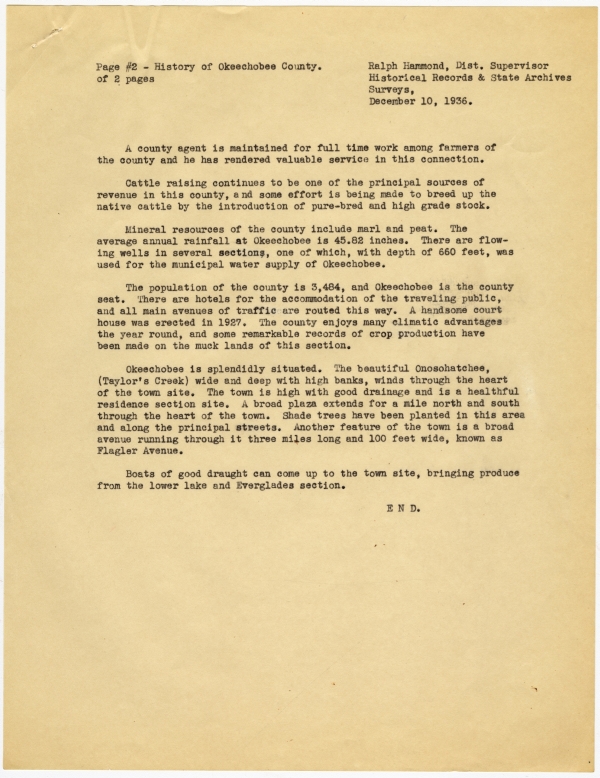Page 1 of 2 pages
Ralph Hammond, District Supervisor,
Historical Record and State Archives,
December 9, 1936. (Surveys,
HISTORY OF OKEECHOBEE COUNTY, FLORIDA
Okeechobee County (Big Water) was formed on August 17, 1917. This county is situated in the southeast central part of Florida and is located forty miles from the Atlantic Ocean on the east, eighty miles from the Gulf of Mexico on the west and is bordered on the south by the great lake which bears its name. This lake is the second largest body of fresh water wholly within the United States without a natural outlet.
There are 484,015 acres in the total area of the county, of which 2,176 acres are in farms and 1,296 acres in actual cultivation. There are three principal soil types. The south and west rim, where muck is found around the shores of Lake Okeechobee and the Kissimmee River valley, is a strip eight miles wide at certain points and containing about 75,000 acres of organic soil which is especially adapted to truck growing, tropical fruits and sugar cane. In the eastern and north central parts of the county there are approximately 175,000 acres of original long-leaf pine interspersed with some fine hammock land. It is fairly well drained and when properly handled is very adaptable to the production of strawberries, truck and field crops, celery and forage crops. In the west central and northern parts of the county is found flatwood prairie and flatwood palmetto land which is underlaid with a hard-pan of chocolate-colored formation and has a growth of native grasses, saw palmetto, and Cuban pine, with some cabbage palmetto and cypress hammocks which will produce good truck crops with proper water control. This prairie section of the county has been used for cattle ranges over a long period of time and many herds feed there.
Irish potatoes, sweet potatoes, field peas and corn are grown to some extent and in certain localities truck crops such as peppers, cabbage, tomatoes, string beans, lima beans and cucumbers have been very successfully produced.
The county has a large acreage of virgin timber which has been estimated to contain 700,000,000 feet of pine and 100,000,000 feet of cypress. Several lumber concerns operate here, and there are also plants handling naval stores. A number of lime rock beds have been found and these furnish material for road-making.
There are two commercial fisheries operated at Okeechobee, one of which is among the largest catfish plants in the United States, handling nearly $1,000,000 worth of fish annually.
The transportation facilities are excellent, as the county is served by two main line railroads and has a considerable mileage of hard-surfaced highways. State Road No. 8, cross-state highway, passes through the county, and the Connors Highway skirts the eastern edge of Lake Okeechobee.
There is a good school system with ten elementary schools and one high school. School property of the county is valued at $157,550.
Page #2 - History of Okeechobee County.
of 2 pages
Ralph Hammond, Dist. Supervisor
Historical Records & State Archives
Surveys,
December 10, 1936.
A county agent is maintained for full time work among farmers of the county and he has rendered valuable service in this connection.
Cattle raising continues to be one of the principal sources of revenue in this county, and some effort is being made to breed up the native cattle by the introduction of pure-bred and high grade stock.
Mineral resources of the county include marl and peat. The average annual rainfall at Okeechobee is 45.82 inches. There are flowing wells in several sections, one of which, with depth of 660 feet, was used for the municipal water supply of Okeechobee.
The population of the county is 3,484, and Okeechobee is the county seat. There are hotels for the accommodation of the traveling public, and all main avenues of traffic are routed this way. A handsome court house was erected in 1927. The county enjoys many climatic advantages the year round, and some remarkable records of crop production have been made on the muck lands of this section.
Okeechobee is splendidly situated. The beautiful Onosohatchee, (Taylor's Creek) wide and deep with high banks, winds through the heart of the town site. The town is high with good drainage and is a healthful residence section site. A broad plaza extends for a mile north and south through the heart of the town. Shade trees have been planted in this area and along the principal streets. Another feature of the town is a broad avenue running through it three miles long and 100 feet wide, known as Flagler Avenue.
Boats of good draught can come up to the town site, bringing produce from the lower lake and Everglades section.
E N D.




 Listen: The Blues Program
Listen: The Blues Program